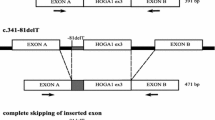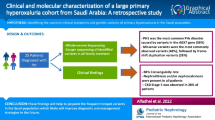Abstract
Primary hyperoxaluria type 1 (PH1) is a rare genetic kidney disease caused by a deficiency of alanine:glyoxylate aminotransferase (AGT). Genetic heterogeneity of the AGT gene cannot fully account for heterogeneity in the clinical phenotype. This study investigates a possible contribution to the clinical phenotype from SNPs in RET or PAX2 genes associated with reduced nephron number. The frequencies of these SNPs were compared in PH1-affected DNA samples and normal controls, and relative to age of onset in PH1-affected individuals. The frequencies of the risk alleles were higher with early age of onset, although not significantly so. However, homozygosity for the risk alleles of RET and PAX2 was not seen in the late onset group. The overall frequencies of risk alleles and the numbers of homozygotes were significantly higher for PAX2 in PH1 samples versus controls, suggestive of a bias towards more severe clinical phenotypes in the PH1 samples submitted for analysis.

Similar content being viewed by others
References
Albert A, Yunta C, Arranz R, Pena A, Salido E, Valpuesta JM, Martin-Benito J (2010) Structure of GroEL in complex with an early folding intermediate of alanine glyoxylate aminotransferase. J Biol Chem 285:6371–6376
Brenner BM, Mackenzie HS (1997) Nephron mass as a risk factor for progression of renal disease. Kidney Int Suppl 63:S124–S127
Cain JE, Di Giovanni V, Smeeton J, Rosenblum ND (2010) Genetics of renal hyperplasia: insights into the mechanisms controlling nephron endowment. Ped Res 68:91–98
Clarke JC, Patel SR, Raymond RM, Andrew S, Robinson BG, Dressler GR, Brophy PD (2006) Regulation of cRet in the developing kidney is responsive to PAX2 gene dosage. Hum Mol Genet 276:3420–3428
Cochat P, Rumsby G (2013) Primary hyperoxaluria. N Engl J Med 369:649–658
Costantini F, Shakya R (2006) GDNF/RET signaling and the development of the kidney. BioEssays 28:117–127
Coulter-Mackie MB, White CT, Chew B, Lange D (2002, updated 2014) Primary Hyperoxaluria Type 1. In: Pagon RA, Adam MP, Bird TD et al. (eds) GeneReviews®. University of Washington, Seattle, WA; 1993–2015. http://www.ncbi.nlm.nih.gov/books/NBK1283/
Danpure CJ (2013) Primary Hyperoxaluria. In: Valle D, Beaudet AL, Vogelstein B, Kinzler KW, Antonarakis SE, Ballabio A, Gibson K, Mitchell G (eds) OMMBID—The Online Metabolic and Molecular Bases of Inherited Diseases. McGraw-Hill, New York, NY Chapter 133
Dziarmaga J, Quinlan J, Goodyer P (2006) Renal hyperplasia: lessons from PAX2. Pediatr Nephrol 21:26–31
Fargue S, Rumsby G, Danpure CJ (2013) Multiple mechanisms of action of pyridoxine in primary hyperoxaluria type 1. Biochim Biophys Acta 1832:1776–1783
Hoppe B (2010) Evidence of true genotype-phenotype correlation in primary hyperoxaluria type 1. Kidney Int 177:383–385
Hoppe B (2012) An update on primary hyperoxaluria. Nat Rev Nephrol 8:467–475
Hoy WE, Bertram JF, Denton RD, Zimanyi M, Samuel Hughson MD (2008) Nephron number, glomerular volume, renal disease and hypertension. Curr Opin Nephrol Hypertens 17:258–265
Köttgen A (2010) Genome-wide association studies in nephrology research. Am J Kidney Dis 56:743–758
Luyckx VA, Brenner BM (2005) Low birthweight, nephron number, and kidney disease. Kidney Int 68:S68–S77
Luyckx VA, Brenner BM (2010) The clinical importance of nephron mass. J Am Soc Nephrol 21:898–910
Luyckx VA, Bertram JF, Brenner BM, Fall C, Hoy WE, Ozanne SE, Vikse BE (2013) Effect of fetal and child health on kidney development and long term risk of hypertension and kidney disease. Lancet 382:273–283
Mesa-Torres N, Fabelo-Rosa I, Riverol D, Yunta C, Albert A, Salido E, Pey AL (2013) The role of protein denaturation energetics and molecular chaperones in the aggregation an mistargeting of mutants causing primary hyperoxaluria type 1. PLoS One 8:e71963
Montioli R, Roncador A, Oppici E, Mandrile G, Giachino DF, Cellini B, Voltattorni CB (2014) S81L and G170R mutations causing primary hyperoxaluria type 1 in homozygosis and heterozygosis: an example of positive interallelic complementation. Hum Mol Genet 23:5998–6007
Oppici E, Roncador A, Montioli R, Bianconi S, Cellini B (2013) G161 mutations associated with primary hyperoxaluria type 1 induce the cytosolic aggregation and the intracellular degradation of the apo-form of alanine:glyoxaylate aminotransferase. Biochim Biophys Acta 1832:2277–2288
Puddu M, Fanos V, Podda F, Zaffanello M (2009) The kidney from prenatal to adult life: perinatal programming and reduction of number of nephrons during development. Am J Nephrol 30:162–170
Quigley R (2012) Developmental changes in renal function. Curr Opin Pediatr 24:184–190
Quinlan J, Lemire M, Hudson T, Qu H, Benjamin A, Roy E, Pascuet E, Goodyer M, Raju C, Zhang Z, Houghton F, Goodyer P (2007) A common variant of the PAX2 gene is associated with reduced newborn kidney size. J Am Soc Nephrol 18:1915–1921
Santana A, Salido E, Torres A, Shapiro LJ (2003) Primary hyperoxaluria type 1 in the Canary Islands: a conformational disease due to I244T mutation in the P11L-containing alanine:glyoxylate aminotransferase. Proc Natl Acad Sci USA 100:7277–7282
Williams E, Acquaviva A, Chevalier F, Coulter-Mackie B, Monico C, Giachino D, Robbiano A, Salido E, Waterham H, Rumsby G (2009) Primary hyperoxaluria type 1: update and additional mutation analysis of the AGXT gene. Hum Mut 30:910–917
Zhang Z, Quinlan J, Hoy W, Hughson M, Lemire M, Hudson T, Hueber P, Benjamin A, Roy A, Pascuet E, Goodyer M, Raju C, Houghton F, Bertram J, Goodyer P (2008) A common RET variant is associated with reduced newborn kidney size and function. J Am Soc Nephrol 19:2017–2034
Conflicts of interest
None.
Author information
Authors and Affiliations
Corresponding author
Rights and permissions
About this article
Cite this article
Coulter-Mackie, M.B. SNP Variants in RET and PAX2 and Their Possible Contribution to the Primary Hyperoxaluria Type 1 Phenotype. Biochem Genet 53, 23–28 (2015). https://doi.org/10.1007/s10528-015-9667-z
Received:
Accepted:
Published:
Issue Date:
DOI: https://doi.org/10.1007/s10528-015-9667-z




